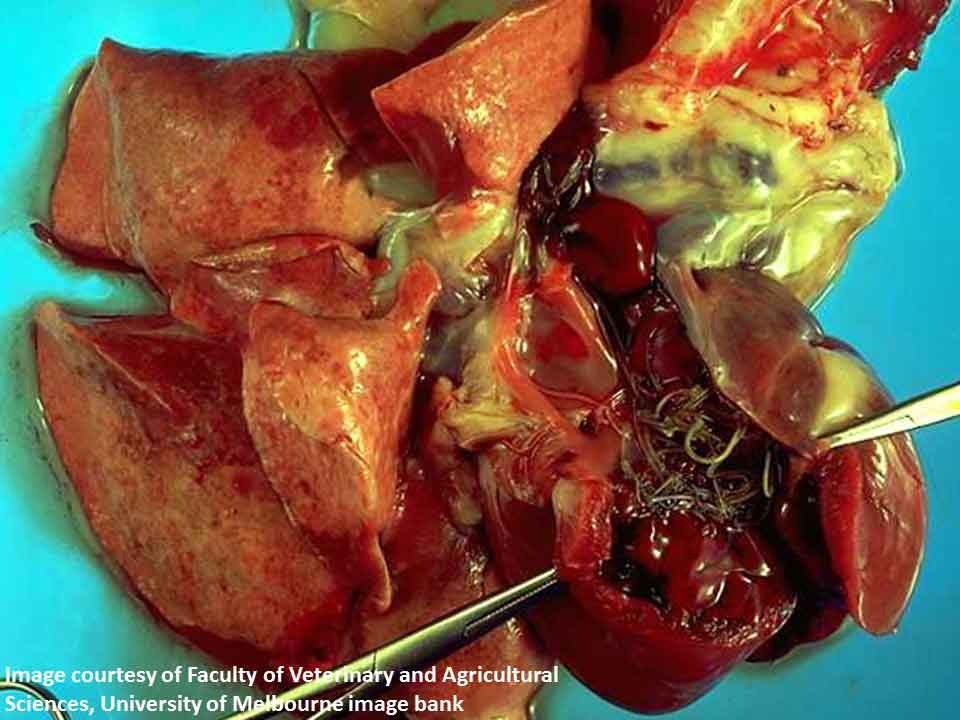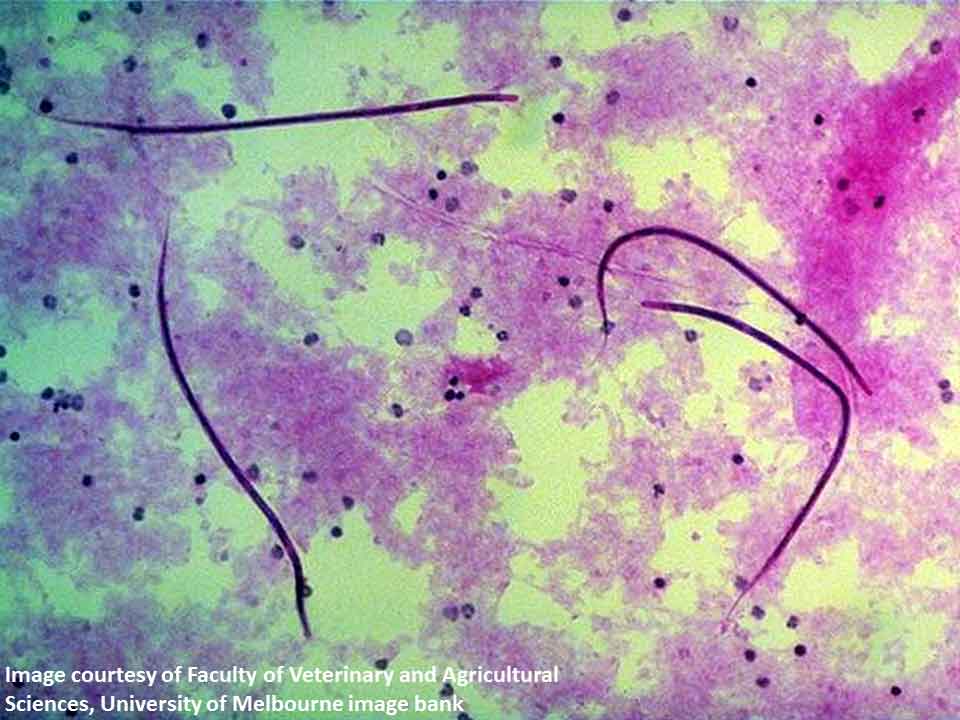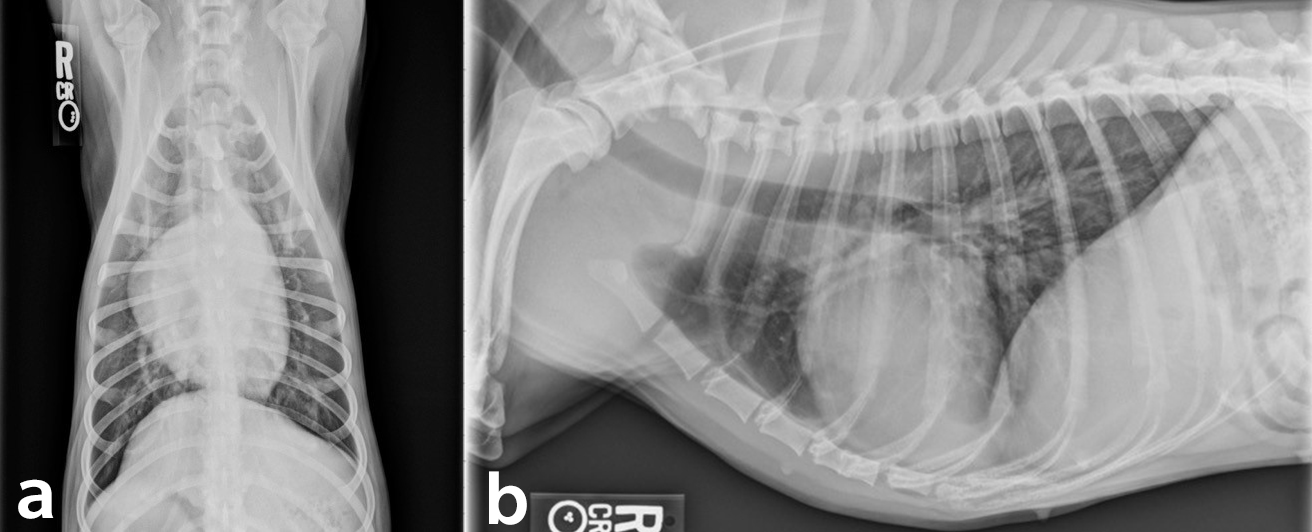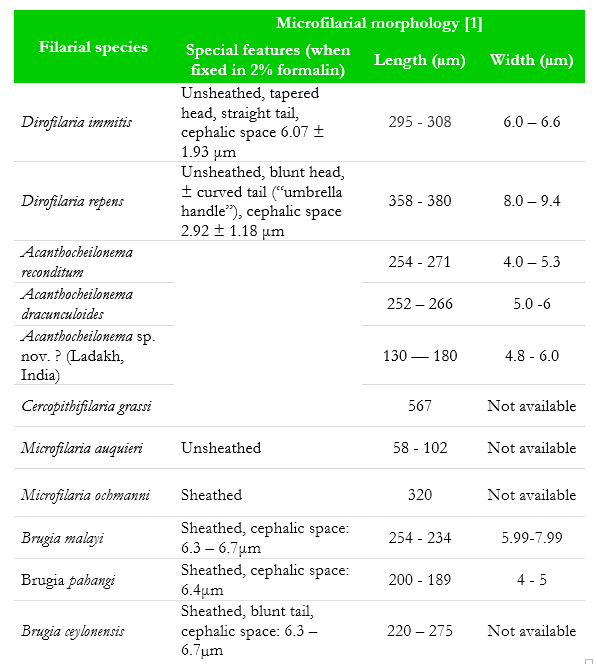Heartworm
(Dirofilaria immitis)
Dirofilaria immitis (heartworm) is a filarial nematode of dogs (and cats) transmitted by mosquitoes. It is a leading cause of right-side congestive heart failure, pulmonary disease and death in dogs in the tropics and sub-tropics. It is zoonotic, although only rarely causes illness in people.
| Parasite: Dirofilaria immitis |
| Common name: Heartworm |
| Host: Dogs, wild canids |
| Pre-patent period: 6 – 9 months |
| Location of adults: Pulmonary artery |
| Distribution: Tropical and sub-tropical regions |
| Transmission route: Mosquitoes |
| Zoonotic: Yes |
Distribution
Worldwide, although occurrence in some cooler climatic regions can be limited. Widespread in tropical and sub-tropical regions.
Clinical signs
Clinical signs relate to progressive chronic heartworm disease. In early stages of infection, dogs are usually asymptomatic but they advance over a period of months-to-years to manifest chronic progressive pulmonary and congestive heart disease. At this stage, clinical signs may include cough, exercise intolerance, weight loss and lethargy. As the disease progresses, dyspnoea, tachypnoea, haemoptysis, tachycardia, cardiac murmur, syncope, hepatomegaly, ascites and renal insufficiency may ensue. Caval syndrome (Fig 1) with haemolysis may develop, creating additional signs of laboured breathing, pallor, icterus and haemoglobinuria.

Figure 1 Adult heartworms recovered from a dog with caval syndrome. (Image credit: The University of Melbourne, parasite image library)

Figure 2 Microfilariae of Dirofilaria immitis. (Image credit: The University of Melbourne parasite image library)
Diagnosis
Based on history (e.g. lack of heartworm prophylaxis, coughing) and physical examination findings, a diagnosis of heartworm disease should be confirmed using a commercial heartworm antigen detection test as well as a microfilarial detection test using a concentration technique; the modified Knott’s or filtration test (SOP 5) for example. In many geographical locations circulating microfilarial densities peak in the late afternoon and evening, especially once the animal has eaten a meal. Blood collection during these periods will reduce the probability of a false negative microfilarial detection test. Care should be taken to morphologically differentiate (Fig 2, Table 3) microfilariae of D. immitis from other filarial parasites occurring in the area (e.g. Dirofilaria repens, Acanthocheilonema spp., Brugia spp.). Occult infections (lack of observed microfilariae) may complicate diagnosis
Table 3 Summary of filarial species infecting dogs and their distinguishing features
Imaging tools e.g., radiography (Fig 3) and echocardiography may aid diagnosis and determine the severity of disease.

Treatment
Coughing dogs with confirmed heartworm infection should be managed symptomatically with anti-inflammatory doses of corticosteroid while specific treatment (see below) is started. Dogs exhibiting severe clinical signs of heartworm disease should be stabilized before administering an adulticide by administration of ancillary medications such as glucocorticosteroids, diuretics, vasodilators, positive inotropic agents, and fluid therapy.
The following guidelines are based on those developed and refined over decades by the American Heartworm Society (https://www.heartwormsociety.org).
Dogs should be exercise-restricted, commenced on monthly or injectable macrocyclic lactone and doxycycline (10 mg/kg twice daily, for 4 weeks) two months before the initial administration of melarsomine dihydrochloride. Melarsomine should be administered at 2.5 mg/kg by deep intramuscular injection into the epaxial lumbar muscles, and a second and third dose administered again after one month, 24 hours apart.
In countries where melarsomine is unavailable, a ‘slow-kill’ regime using a combination of a macrocyclic lactone and doxycycline may be the only adulticidal option.
Oral ivermectin 6 µg/kg administered at 2-weekly intervals for 6 months together with doxycycline 10 mg/kg twice daily for 30 days, resulted a negative heartworm antigen test in 72% of dogs tested 12 months following the commencement of therapy [2].
Alternatively, oral ivermectin 6µg/kg administered weekly; in combination with doxycycline 10 mg/kg twice daily, administered for 6 weeks, at monthly intervals for a total of 36 weeks, had an efficiency of 78% against adult heartworms [3].
Heartworm antigen testing should be performed after 6 months of commencing therapy and every 3 months thereafter. The dog is considered heartworm negative after two consecutive negative antigen tests. If the dog is still positive, doxycycline therapy should be repeated.
Veterinarians should be made aware that during the entire course of slow-kill therapy pathology may continue to develop while the adults are alive. Complications or sudden death due to pulmonary emboli owing to death of adult worms may also occur. Exercise restriction is recommended throughout this time.
TroCCAP strongly advocates the use of melarsomine as an adulticide.“Slow-kill” may promote the risk of heartworm developing resistance to macrocyclic lactones.
Control
Chemoprophylaxis with a macrocyclic lactone should commence as early as possible (6–8 weeks of age), according to labelled recommendations. Dogs should be tested for heartworm on an annual basis regardless of prophylaxis use to monitor product efficacy and owner compliance. Mosquito control through the use of repellents e.g. pyrethroids should be applied to the dog.
Public health considerations
Dirofilaria immitis may rarely infect humans. In humans, the worms may be found within granulomas in the lung that resemble ‘coin-like’ lesions on radiographs. Most reported human cases are asymptomatic, however in rare cases, cough, chest pain and haemoptysis may ensue. Ocular infections with adult worms have also been reported.
References
[1] Magnis J, Lorentz S, Guardone L, Grimm F, Magi M, Naucke T, Deplazes P. Morphometric analyses of canine blood microfilariae isolated by the Knott’s test enables Dirofilaria immitis and D. repens species-specific and Acanthocheilonema (syn. Dipetalonema) genus-specific diagnosis. Parasit Vectors. 2013;6:48.
[2] Grandi G, Quintavalla C, Mavropoulou A, Genchi M, Gnudi G, Bertoni G, Kramer L. A combination of doxycycline and ivermectin is adulticidal in dogs with naturally acquired heartworm disease (Dirofilaria immitis). Vet Parasitol. 2010;169:347-351.
[3] Bazzocchi C, Mortarino M, Grandi G, Kramer LH, Genchi C, Bandi C, Genchi M, Sacchi L, McCall JW. Combined ivermectin and doxycycline treatment has microfilaricidal and adulticidal activity against Dirofilaria immitis in experimentally infected dogs. Int J Parasitol. 2008;38:1401-1410.

